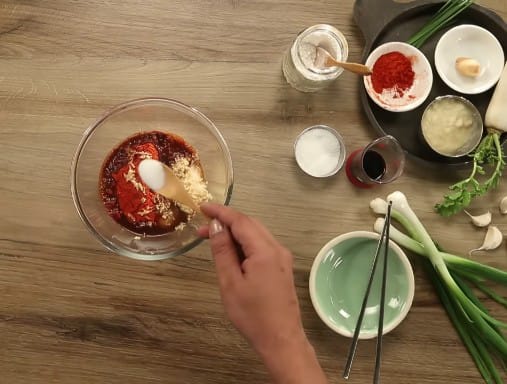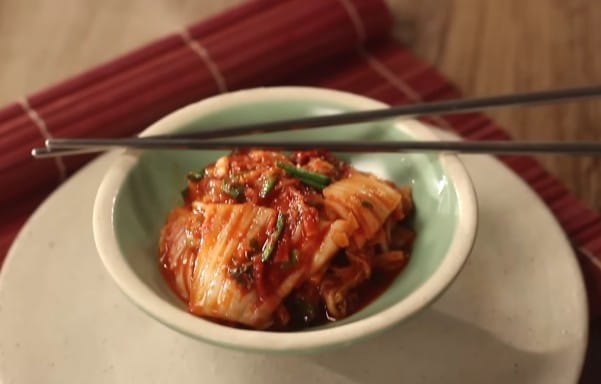Kimchi: The Best Korean Dish

Kimchi
Have you ever tasted a dish so bold and flavorful that it leaves a lasting impression on your palate? If not, then you must try kimchi, a beloved staple of Korean cuisine that’s not only rich in taste but also packed with health benefits. With its signature spicy and tangy flavors, kimchi is a dish that excites both the taste buds and the senses.
My First Time Trying Kimchi
I’ll never forget the first time I tasted kimchi. It was during a trip to South Korea, and I was eager to try the famous dish. At a cozy little restaurant in Seoul, I was served a small plate of kimchi on the side. The bright red color and strong smell made me hesitate, but I was curious.
When I took my first bite, the flavor surprised me. It was spicy, sour, and crunchy all at once. I had never tasted anything like it before, and I found myself wanting more. That meal sparked my love for Korean food.
When I came back home, I decided to make my own kimchi. My first attempts weren’t perfect, but with practice, I got better. Now, making kimchi at home has become a fun part of my cooking routine. It’s always rewarding to see it transform over time.
For me, kimchi isn’t just a side dish—it’s a reminder of my travels and my passion for trying new foods.

What is Kimchi?
Kimchi is a traditional Korean dish made from fermented vegetables, primarily Napa cabbage and radishes, with a blend of chili pepper, garlic, ginger, and fish sauce. It's known for its distinctive spicy, sour, and umami-rich taste. The fermentation process not only gives kimchi its unique flavor but also turns it into a nutritional powerhouse filled with probiotics that support gut health.
The History of Kimchi
Kimchi has a history that spans over two thousand years, rooted deeply in Korean culture. Originally created as a method of preserving vegetables for the harsh winters, kimchi evolved through time with the introduction of chili peppers in the 16th century. Over time, it became a vital part of the Korean diet, symbolizing the resilience and adaptability of Korean people.
Ingredients Required to Make Kimchi
- Napa Cabbage: 500 grams (about half a medium-sized cabbage)
- Korean Radish (Mu): 100 grams, thinly sliced or julienned
- Korean Red Chili Pepper Flakes (Gochugaru): 2 tablespoons (adjust to your spice preference)
- Garlic: 3 cloves, minced
- Ginger: 1 teaspoon, grated
- Fish Sauce or Shrimp Paste: 1 tablespoon (use soy sauce for a vegetarian option)
- Salt: 2 tablespoons (for brining the cabbage)
- Sugar (optional): 1 teaspoon (to balance the flavors)
This ingredient list is perfect for a small batch of kimchi, serving two people!
Click below to get started on your homemade kimchi adventure!
How to Make Kimchi
1) - Brine the cabbage: Cut the Napa cabbage into quarters and soak them in salted water for several hours. This helps draw out moisture and kickstarts the fermentation process.

2)- Prepare the kimchi paste: In a bowl, mix gochugaru (Korean chili flakes), minced garlic, grated ginger, and fish sauce. This forms the base of the kimchi’s flavor.

3)- Add radish: Julienne or slice Korean radish into thin pieces and mix it into the paste.

4)- Combine: Once the cabbage is soft and pliable, rinse it thoroughly and then coat each leaf with the prepared chili paste.

5)- Fermentation: Place the coated cabbage into an airtight jar, leaving a bit of space for the fermentation gases. Let it sit at room temperature for 1-5 days depending on how tangy you prefer your kimchi, then refrigerate.

6)- Enjoy: Once fermented, kimchi can be enjoyed immediately or stored in the refrigerator for months, where it will continue to develop more complex flavors.

Tips for Making Perfect Kimchi
- Control the spice level: If you're not a fan of spicy food, reduce the amount of gochugaru.
- Add variety: Other vegetables like carrots or green onions can be included for different textures.
- Adjust to taste: Kimchi is highly customizable; if you prefer sweeter kimchi, add more sugar to the paste.
- Use gloves: The chili paste can stain and burn, so wearing gloves when applying the paste is recommended.
What Does Kimchi Taste Like
Kimchi has a unique and bold taste that combines a mix of flavors. It's usually spicy, sour, tangy, and a little bit salty. The fermentation process gives it a sourness, similar to pickles, but with more complexity. The spices, like red pepper flakes, garlic, and ginger, add heat and depth to the flavor. Depending on the vegetables used, like napa cabbage or radish, and how long it's been fermented, the taste can vary from mild and fresh to more intense and pungent. Overall, kimchi is a flavorful, zesty dish that can be enjoyed in many ways.
Health Benefits of Kimchi
Kimchi is not just a flavorful dish; it's also a nutritional powerhouse. Here are some of its notable health benefits:
- Rich in Probiotics: Due to its fermentation process, kimchi is loaded with beneficial bacteria that promote gut health and aid digestion.
- High in Vitamins and Antioxidants: Kimchi provides an excellent source of Vitamin A, Vitamin C, and antioxidants, which help boost the immune system and fight inflammation.
- Aids in Weight Management: Low in calories but high in fiber, kimchi is a filling food that can help with weight control.
- Supports Heart Health: The garlic and ginger in kimchi contribute to lowering cholesterol and improving heart function.
- Promotes Skin Health: The vitamins in kimchi, along with the probiotics, can help improve skin elasticity and fight signs of aging.
Nutrition in Kimchi
| Nutrient | Per Serving (Approximate) |
| Calories | 30-40 kcal |
| Protein | 2-3 g |
| Carbohydrates | 4-6 g |
| Fats | 0-1 g |
| Fiber | 2-3 g |
| Vitamin A | 20-25% of DV |
| Vitamin C | 30-40% of DV |
| Vitamin K | 20-30% of DV |
| Antioxidants | High |
| Probiotics | High |
Curious About the Details Health Benefits of Kimchi?
For more details on its nutrition and why it’s so good for you, click here! 🌿
Beyond its taste and health benefits, kimchi is integral to Korean identity and culture. It is served with nearly every meal and comes in over 200 variations, each region of Korea offering its unique take on the dish.
Different Types of Kimchi
- Baechu Kimchi: The classic kimchi made with Napa cabbage.
- Kkakdugi: A radish kimchi that’s chunkier and has a crunchier texture.
- Chonggak Kimchi: Made from ponytail radishes, this variety is smaller and often has a spicier taste.
- White Kimchi (Baek Kimchi): A milder, non-spicy version without gochugaru, perfect for those who prefer less heat.
Dishes Served with Kimchi
Kimchi is often served as a side dish (banchan) in Korean cuisine, but it also plays a starring role in many recipes. Some popular dishes include:
- Kimchi Jjigae: A spicy kimchi stew with tofu and pork. ( Click Here For Full Recipe )
- Kimchi Bokkeumbap: Kimchi fried rice, perfect for a quick meal.
- Kimchijeon: Kimchi pancakes, a crispy and savory snack.
Suggestions for Enjoying Kimchi
- Pair kimchi with rice, as it balances the strong flavors.
- Use kimchi as a topping for burgers, sandwiches, or even pizza.
- Add it to soups and stews for a flavor boost.
Frequently Asked Questions About Kimchi
- What is kimchi?
- Kimchi is a traditional Korean dish made from fermented vegetables, primarily cabbage and radishes, with chili paste, garlic, ginger, and fish sauce. - How is kimchi made?
- Kimchi is made by brining cabbage, coating it in a spicy paste, and letting it ferment in an airtight container for several days. - Is kimchi healthy?
- Yes, kimchi is packed with probiotics, vitamins, and antioxidants, making it a nutritious addition to any diet. - Is kimchi spicy?
- Most kimchi varieties are spicy due to the chili paste, but milder versions exist. - Can I make kimchi at home?
- Yes! Kimchi is easy to make at home with simple ingredients and basic fermentation techniques. - How long does kimchi last?
- Kimchi can be stored in the refrigerator for several months, where its flavor will continue to develop.
Conclusion:
Kimchi is not only a flavorful and versatile dish but also a symbol of Korean culture and tradition. Packed with health benefits and bursting with flavor, it's a dish that can elevate any meal. Whether you enjoy it as a side, in a stew, or even on a burger, kimchi is an essential addition to your culinary repertoire. Try making it today and bring the vibrant flavors of Korea into your kitchen!
Loved This Kimchi Recipe? Try Another Korean Classic!
Recipe Card
Kimchi is a traditional Korean dish made from fermented vegetables, primarily Napa cabbage and radishes, with a blend of chili pepper, garlic, ginger, and fish sauce. It’s known for its distinctive spicy, sour, and umami-rich taste. The fermentation process not only gives kimchi its unique flavor but also turns it into a nutritional powerhouse filled with probiotics that support gut health.
- 500 g Napa Cabbage (about half a medium-sized cabbage)
- 100 g Korean Radish (Mu) (thinly sliced or julienned)
- 2 tablespoon Korean Red Chili Pepper Flakes (Gochugaru) (adjust to your spice preference)
- 3 Garlic (cloves, minced)
- 1 teaspoon Ginger (grated)
- 1 tbsp Fish Sauce or Shrimp Paste (use soy sauce for a vegetarian option)
- 2 tablespoons Salt (for brining the cabbage)
- 1 tablespoons Sugar (optional) (to balance the flavors)
- Brine the cabbage
Cut the Napa cabbage into quarters and soak them in salted water for several hours. This helps draw out moisture and kickstarts the fermentation process.
- Prepare the kimchi paste
In a bowl, mix gochugaru (Korean chili flakes), minced garlic, grated ginger, and fish sauce. This forms the base of the kimchi’s flavor.
- Add radish
Julienne or slice Korean radish into thin pieces and mix it into the paste.
- Combine
Once the cabbage is soft and pliable, rinse it thoroughly and then coat each leaf with the prepared chili paste.
- Fermentation
Place the coated cabbage into an airtight jar, leaving a bit of space for the fermentation gases. Let it sit at room temperature for 1-5 days depending on how tangy you prefer your kimchi, then refrigerate.
- Enjoy
Once fermented, kimchi can be enjoyed immediately or stored in the refrigerator for months, where it will continue to develop more complex flavors.
Servings 2
- Amount Per Serving
- Calories 40kcal
- % Daily Value *
- Total Carbohydrate 6g2%
- Dietary Fiber 3g12%
- Protein 3g6%
* Percent Daily Values are based on a 2,000 calorie diet. Your daily value may be higher or lower depending on your calorie needs.
Tips for Making Perfect Kimchi
- Control the spice level: If you’re not a fan of spicy food, reduce the amount of gochugaru.
- Add variety: Other vegetables like carrots or green onions can be included for different textures.
- Adjust to taste: Kimchi is highly customizable; if you prefer sweeter kimchi, add more sugar to the paste.
- Use gloves: The chili paste can stain and burn, so wearing gloves when applying the paste is recommended.
THANK YOU
 Hi, I'm Sagar Rakshit, a food blogger based in India. I'm happily married and have the joy of sharing my life with my amazing family. My passion lies in exploring different cuisines, creating delicious recipes, and sharing my culinary adventures with you all.
Hi, I'm Sagar Rakshit, a food blogger based in India. I'm happily married and have the joy of sharing my life with my amazing family. My passion lies in exploring different cuisines, creating delicious recipes, and sharing my culinary adventures with you all.



